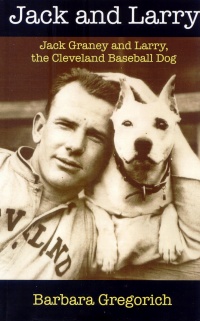| ________________
CM . . . . Volume XVIII Number 39 . . . . June 8, 2012
excerpt:
When today’s young fans of professional baseball think of team mascots, they likely have in mind costumed cartoon-like figures, such as Atlanta’s Homer the Brave, Fredbird of the St. Louis Cardinals or Miami’s Billy The Marlin. However, long before the San Diego Chicken popularized the current fad of costumed critters, teams were known to use real animals as mascots. Gregorich’s Jack and Larry speaks to one such four-legged mascot. Until I read Jack and Larry for this review, I had no knowledge of John “Jack” Gladstone Graney, who was born in St. Thomas, ON, and who, from 1910-1922, played left field and was the leadoff hitter for the Cleveland Naps (later the Indians), a team in the American League. Though Jack began his career with the Cleveland team in 1910, Gregorich’s free verse biography starts with 1912's spring training camp and Jack’s fears that the rumors he has been hearing about his being traded to the Detroit Tigers have a factual basis. The rumors prove to be false, but the 1912 season is a disaster for both Jack and his team. When Jack breaks his shoulder diving after a line drive, he’s out for the season, and the team finishes 30 games out of first place. The one bright spot for Jack is that the team’s trainer won a dog, a young bull terrier named Jack, in a bet, and, during spring training, the trainer gave it to the team who made it their official team mascot. In turn, the team’s manager assigned ownership (and care responsibilities) to Jack, and man and dog bond during Jack’s shoulder rehab.The remainder of the book progresses chronologically as, with each new season, Jack thinks this will be the year Cleveland will win the pennant. Finally, in 1920, the Cleveland Indians win the American League Pennant and meet and best the Brooklyn Robins in a best of nine game World Series matchup. Unfortunately, Larry was not part of the celebrations as, during the 1917 season, he had died of injuries suffered in a fight with another dog. The book winds up very quickly after the championship win, explaining that Jack played two more seasons, retiring in 1922, and then returned to the game in 1932 as a radio broadcaster, “the first former major leaguer to turn sports announcer.” Jack retired from broadcasting in 1953 and died in 1978. The book’s engaging photographic cover suggests that Jack and Larry might be a warm “boy and his dog” tale, but it’s fundamentally Jack’s story and his quest to win a championship. Though Gregorich includes numerous Larry-based anecdotes, such a Larry’s being the first dog ever formally introduced to a sitting US President, Larry is just the voiceless “sidekick” in this biography. Fans of baseball history will recognize the names of some of Jack’s teammates, such as Shoeless Joe Jackson, and will be aware of the significance of Jack’s being the first batter to face, and get a hit off, a rookie pitcher by the name of Babe Ruth. Today’s readers may be amused that baseball teams travelled to away games by train, or they may wonder why hotel elevators required a special person to operate them. Gregorich’s use of free verse makes the book a quick read. Sometimes, when Gregorich believes that the content of her poetry needs some factual clarification, she will add some boxed text at the bottom of a page. For example, in connection with the excerpt above, Three Wrongs, which introduces Larry, Gregorich utilizes such text to explains the origins of Jack’s breed. A closing page about the author states that “Barbara wrote Jack and Larry for kids, but many adults will find that this heartfelt true story from baseball history is for them, too.” In Canada, I think the book’s principal readership will actually be found amongst adult fans of baseball, especially those who are into the sport’s history. While some kids may be initially attracted to what they think is a dog story, the lack of dog content, the “ancient” time period, plus the episodic “plot”, will unfortunately cause many/most of them to abandon the book. Recommended with reservations. Dave Jenkinson, CM’s editor, lives in Winnipeg, MB.
To comment on this title or this review, send mail to cm@umanitoba.ca. Copyright © the Manitoba Library Association. Reproduction for personal use is permitted only if this copyright notice is maintained. Any other reproduction is prohibited without permission.
NEXT REVIEW | TABLE OF CONTENTS FOR THIS ISSUE - June 8, 2012. AUTHORS | TITLES | MEDIA REVIEWS | PROFILES | BACK ISSUES | SEARCH | CMARCHIVE | HOME |
||||||
